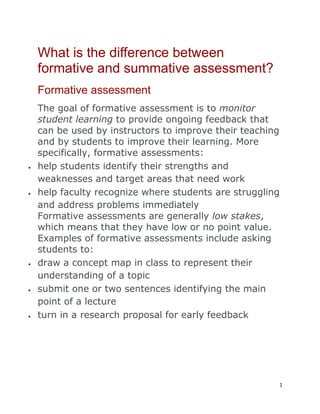Formative and summative assessment
- 1. 1 What is the difference between formative and summative assessment? Formative assessment The goal of formative assessment is to monitor student learning to provide ongoing feedback that can be used by instructors to improve their teaching and by students to improve their learning. More specifically, formative assessments: help students identify their strengths and weaknesses and target areas that need work help faculty recognize where students are struggling and address problems immediately Formative assessments are generally low stakes, which means that they have low or no point value. Examples of formative assessments include asking students to: draw a concept map in class to represent their understanding of a topic submit one or two sentences identifying the main point of a lecture turn in a research proposal for early feedback
- 2. 2 Summative assessment The goal of summative assessment is to evaluate student learning at the end of an instructional unit by comparing it against some standard or benchmark. Summative assessments are often high stakes, which means that they have a high point value. Examples of summative assessments include: a midterm exam a final project a paper a senior recital Information from summative assessments can be used formatively when students or faculty use it to guide their efforts and activities in subsequent courses.


